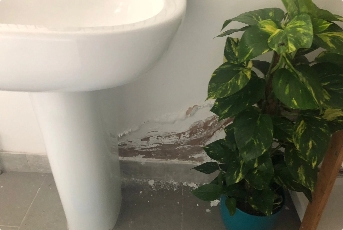Climate Change and Damp: How London Homes Are Affected
Over the past few decades, climate change has led to warmer and wetter winters in the UK. This has contributed to an increase in damp and mould issues within London homes. Rising damp is a particular concern for many Londoners.
What is Rising Damp?
Rising damp is caused by rainwater soaking into the ground and being drawn up into the porous materials of walls and floors via capillary action. A functional damp proof course prevents this from happening, but many older properties either don’t have one or it has failed.
As London has experienced more winter rainfall due to climate change, rising damp has become more prevalent.
The main consequence of rising damp is the appearance of unwanted moisture in walls, which leads to black mould growth, crumbling plaster, rotten skirting boards and a musty smell. If left untreated, it can cause serious damage to the entire structure of a building.
How Climate Change Worsens Rising Damp
Wetter winters, more intense rainfall and warmer temperatures are all effects of climate change that exacerbate rising damp in London homes in the following ways:
- Increased winter precipitation saturates the ground to a higher level, providing more moisture to rise up through walls via capillary action.
- Warmer winters mean more of the rainfall ends up soaking into the ground rather than running off the surface. This adds to the moisture available for rising damp.
- Milder winters also mean walls stay damp for longer, as the drying potential is reduced.
- Intense ‘flash’ rainfall can overload drainage systems, causing localised flooding and excessive ground saturation.
- Higher atmospheric moisture levels increase the amount of moisture available to enter building materials.
How Homeowners Are Affected
For many Londoners living in older properties, rising damp is a frustrating and costly issue. The persistent moisture can make homes feel cold and uncomfortable as well as damaging their value.
- Dealing with mould growth, crumbling plaster and musty odours requires continual redecoration and repairs.
- Damp areas often cannot be used, reducing usable living space. Wet walls cannot be easily covered by wallpaper or panelling.
- Penetrating moisture reduces thermal efficiency, increasing heating costs.
- In severe cases, timber structural elements may rot, requiring major remediation work.
- Left unchecked, ongoing damp problems can affect health and make selling or renting out properties difficult.
With climate change expected to continue to drive wetter winters in London, rising damp issues in homes across the city are likely to escalate. Homeowners will need to be vigilant and proactive in addressing damp to prevent it from impacting their properties and health.
Solutions for Homeowners
There are several effective solutions homeowners can implement to tackle rising damp:
- Installing a chemical damp-proof course to form a moisture barrier in walls.
- Improving drainage around the property to reduce ground saturation.
- Re-plastering affected walls and treating mould growth.
- Adding ventilation to allow damp walls to dry out more quickly.
- Using waterproof sealants on external walls.
- Maintaining guttering and addressing leaks to minimize water infiltration.
By taking proactive steps, Londoners can mitigate many of the impacts of climate change driven damp and mould within their homes. Seeking professional advice from us is recommended for severe rising damp issues.
